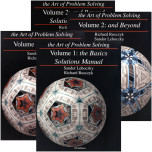We use cookies to make your experience better. To comply with the new e-Privacy directive, we need to ask for your consent to set the cookies. Learn more.
As with the Introductionbooks, the Art of Problem-Solving teaches approaches and methods for solving problems, usually in the context of example solutions, which are reinforced and expanded on by working through the exercises that follow. If you are familiar with the Introduction books, the general philosophy and presentation is basically the same. If you have not used them, PLEASE READ THE PRECEDING DESCRIPTION, as it also applies to this high-school level course. Because this course does not follow a traditional scope and sequence for algebra and geometry, you should consult the table of contents for each volume displayed at our website. Both volumes emphasize geometry, as the authors feel the subject is particularly neglected in most curricula. Think of these books as a banquet for the math-hungry. Students are urged to interact with the books, not just plod through them; to skip around and sample the various topics. If they have trouble digesting something, they should just skip over it and return later when they've had more practice solving problems. They are also encouraged to revisit "finished" topics in order to keep their understanding current.
Lesson text in the volumes is sparse and liberally punctuated with many, many examples. Example solutions are complete and provide the bulk of the instruction. Symbols appear in the margins to help students get the most out of the text. The eye symbol denotes especially important sections that should be read and re-read until understood. The threaded needle indicates difficult problems or concepts which may require additional help or explanation. A bomb highlights potential mistakes that the average math student makes, and helps your child to avoid them. Chapters are relatively short and are divided into smaller sections. This is not a lesson-by-lesson book. Students should work as far as they can in each chapter, depending on their own ease of understanding. Each chapter is followed by problems to solve, often culminated by a "Big Picture" interesting math vignette. Completely worked and explained solutions to the problems are in the meaty Solutions Manualwhich is requisite to the course.
< Did you know that logarithms were actually invented as a trick to do multiplication? They literally turn multiplication and division problems into addition and subtraction ones. Did you know that a formula like the quadratic formula exists for solving cubic equations? It's true and ingeniously simple. If any of this excites you (or more relevantly, your student), this is the course for you. Albert Einstein would have eaten this up as a youth.
Texts are self-study and strictly for the highly-motivated math student. When she finishes these, she will be ready for any college-level math course, to ace the SAT, and to compete in the Mandelbrot Competition. Not only that, but instead of just learning how to work specific math problems, your child will know math in a way that sets him apart from his peers, preparing him for excellence in science, engineering, math, or any other field that requires exceptional problem-solving ability.



